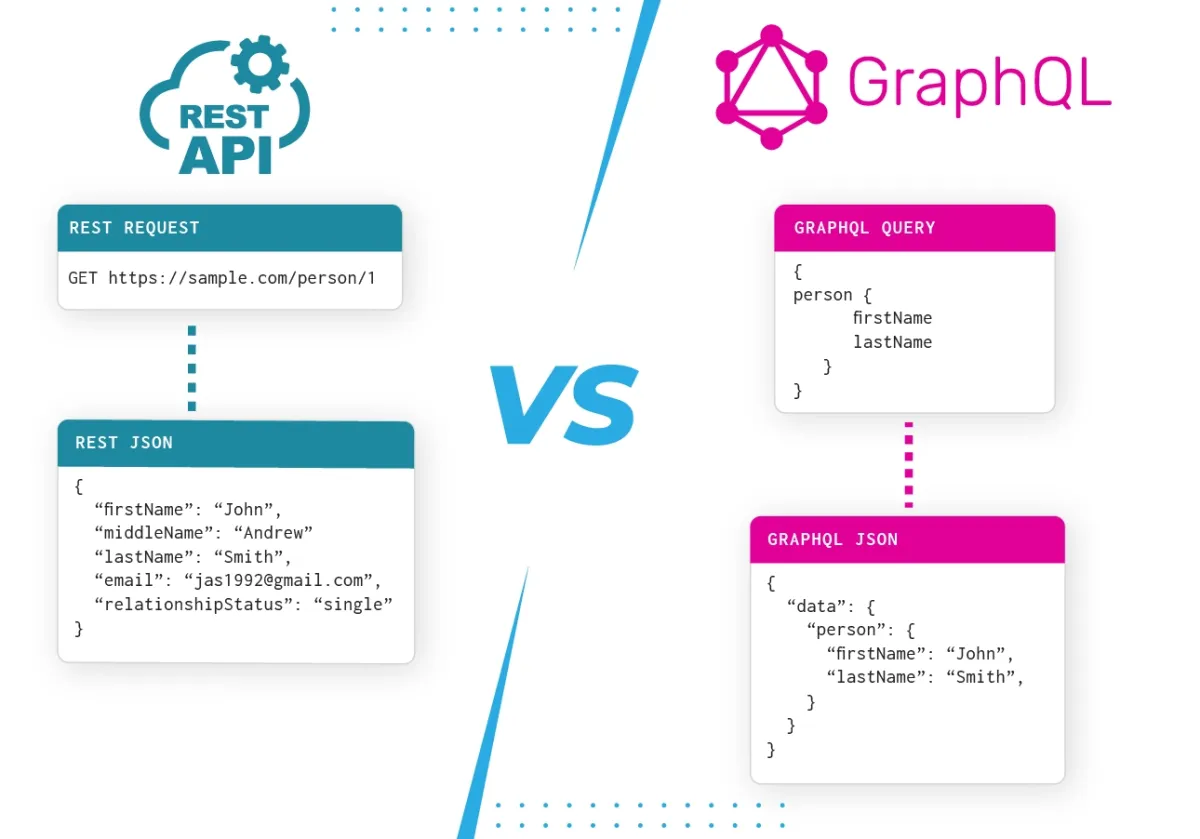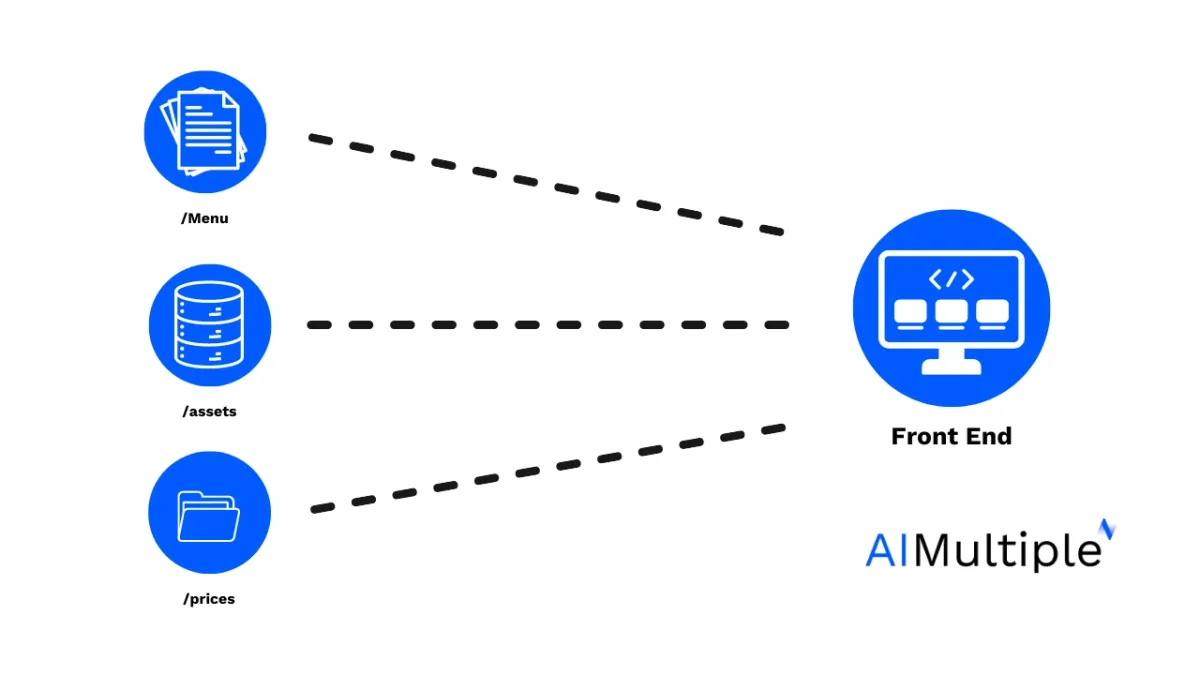Since the release of GraphQL in 2015, there have been comparisons between GraphQL and REST due to their similar end results and GraphQL’s innovative approach. In some instances, GraphQL is even seen as a direct alternative or has been used in conjunction with REST.1
While REST is far more widely used than GraphQL at the moment, industry leaders and big companies such as Facebook, Airbnb, and Github are adopting GraphQL.2 We evaluate the advantages and disadvantages of GraphQL to determine in what instances it may be better to use GraphQL over REST, and vice versa.
GraphQL vs. REST
What are the key differences between GraphQL and REST?
GraphQL is a query language and runtime that allows clients to specify the exact data they need, while REST APIs rely on multiple endpoints to return fixed data structures. REST uses standard HTTP methods like GET, POST, PUT, and DELETE, whereas GraphQL operates through a single endpoint, enabling more flexible and efficient data fetching.
| Feature | GraphQL ✅🚫🟡 | REST ✅🚫🟡 |
|---|---|---|
| Data Fetching | ✅ Fetches only requested fields (efficient) | 🚫 Returns entire resource (over-fetching possible) |
| Endpoint | ✅ Single endpoint (/graphql) | 🟡 Multiple endpoints (/users, /orders, etc.) |
| Performance | ✅ Reduces network requests & payload size | 🟡 Can require multiple requests for related data |
| Flexibility | ✅ Clients define response structure | 🚫 Server dictates response format |
| Versioning | ✅ No need for versioning (schema evolves) | 🚫 Requires API versioning (v1, v2, etc.) |
| Real-time Support | ✅ Built-in via subscriptions | 🚫 Requires WebSockets or polling |
| Complexity | 🚫 Requires schema & resolver setup | ✅ Simpler, follows RESTful principles |
| Caching | 🚫 More complex (no native HTTP caching) | ✅ Easier with HTTP methods (GET caching) |
| Use Case | ✅ Best for dynamic frontends & complex queries | ✅ Best for simple, resource-based APIs |
Advantages of GraphQL over REST
1. Specificity
GraphQL can provide customers with the exact data they need. One of the most common problems with traditional REST APIs is that they tend to cause overfecthing, obtaining more information than needed. A REST query will extract all the data from a specific resource, while GraphQL will only get what is dictated in a query (see Figure 1).
Figure 1: Rest API query vs. GraphQL query

Source: Medium.3
2. Performance
GraphQL can process customized queries which contribute to enhanced performance. Processing customized queries reduce the number of API calls.
Contrary to REST, GraphQL has a single endpoint, it is much more predictable, and there is a lower chance of unnecessary API calls. Research shows that mitigating GraphQL from REST increases performance by 66%4 of the applications.
3. Flexibility
GraphQL allows its user to integrate multiple systems, and it can fetch data from existing systems. This allows GraphQL to be utilized without needing to uninstall existing infrastructures, and it can work with existing API management tools.
4. Less effort to implement
Due to the simplified use of GraphQL, implementing queries requires less effort than REST. Research shows that when executing remote service queries, GraphQL is less time-consuming than REST, with a difference of 9 vs. 6.5
Advantages of REST over GraphQL
1. Single endpoint bottleneck
Research shows that GraphQL performed below its REST counterpart for workloads above 30006 requests due to endpoint bottleneck disadvantage.
While a single endpoint is one of the strengths of GraphqL, it can become a bottleneck in certain circumstances. HTTP’s built-in cache function in REST APIs produces faster results than GraphQL in almost every scenario. This is because REST APIs’ multiple endpoints allow them to use HTTP caching to avoid reloading resources. GraphQL’s single endpoint pushes the user to rely on an additional library.
2. Security
REST’s vast popularity and authentication methods make it a better option for security reasons than GraphQL. While REST has built-in HTTP authentication methods, GraphQL does not provide a specific process to ensure security. The user must figure out their own security methods, whether authentication or authorization. However, users can overcome this issue with a well-planned security plan for using GraphQL.
3. Complexity
While GraphQL offers a caching mechanism, the cache-implementing process is much more complex and time-consuming than REST implementation. This is due to REST’s advantage of allowing the user to access resources with URLs.
4. Cost
One of the significant drawbacks to using GraphQL is that it is more difficult to specify the API rate limit than REST. This creates the risk of the cost of queries being unexpectedly large, leading to computation, resource, and infrastructure overload.7
To overcome such risks, the user must calculate a query’s cost before executing it. However, calculating GraphQL’s queries is challenging due to its nested structure. Thus, it is best to use a machine-learning approach to estimate.
What is GrahpQL?
Figure 2: GraphQL

GraphQL is an open-source query and manipulation language for APIs developed by Facebook in 2012 and released publicly in 2015. Contrary to REST architecture, GraphQL is not an API specification; it’s a runtime for fulfilling queries with existing data. Backbend GraphQL provides a type system that describes a schema for data; in return, this gives front-end API consumers the ability to request the exact data they need.
GraphQL is schema-driven, meaning the server defines a strict schema outlining data types and relationships. Clients query or modify data (create, update, delete) based on this schema, receiving predictable JSON responses. It also supports real-time updates via subscriptions. Its flexibility and efficiency make it ideal for complex, interconnected data scenarios, such as mobile apps requiring minimal network requests.
Web developers utilize REST APIs where data entities live on several URLs on a server. Contrary to multiple URLs and entry points of REST APIs (see Figure 3), GraphQL has a single entry point (see Figure 2). Data is fetched by describing it with a syntax that mirrors its return shape in JSON.8
What is REST?
REST (Representational State Transfer) is an architectural style for building web services that operate over HTTP. It centers around the concept of resources, which are identified by URLs (Uniform Resource Locators), and these resources can be manipulated using standard HTTP methods such as:
- GET (retrieve data),
- POST (create data),
- PUT (update data),
- DELETE (remove data)
RESTful services are stateless, meaning that each request from the client to the server must contain all the necessary information, and the server does not maintain any session state between requests. This simplicity and adherence to the widely understood principles of HTTP have made REST a popular choice for designing APIs.
One of the core benefits of REST is its use of standard HTTP features, including status codes and headers, which allow for simpler error handling and caching. REST services are flexible, enabling data to be exchanged in various formats like JSON, XML, or plain text, depending on the client’s needs. Its clear structure and well-established conventions make it easy to implement and understand, making REST a go-to approach for many web-based applications, particularly when simplicity, scalability, and cacheability are key concerns.
Figure 3: Representation of REST API

Frequently Asked Questions: GraphQL vs. REST
When should I use GraphQL instead of REST?
GraphQL is ideal for applications requiring exact data retrieval, such as mobile apps where reducing multiple API requests enhances performance. It also excels in scenarios with complex data querying, fetching data from multiple data sources, or real-time updates.
What is the GraphQL Schema Definition Language (SDL)?
The GraphQL Schema Definition Language (SDL) defines the structure of a GraphQL API, specifying types, fields, and their relationships. It ensures strongly typed API architecture, allowing clients to query only the necessary data.
How does GraphQL handle multiple API requests?
Unlike REST, which may require multiple REST API requests to retrieve related data, GraphQL allows clients to fetch all necessary information in only one API request. This reduces over-fetching and under-fetching issues common in REST.
Can GraphQL automatically identify request errors?
Yes. GraphQL APIs can automatically identify request errors by providing structured error messages within the response, unlike REST, which typically relies on HTTP status codes for error handling.
How does GraphQL manage caching compared to REST?
REST APIs leverage built-in HTTP methods like ETag and Cache-Control for efficient caching. GraphQL requires a custom caching strategy since its single endpoint structure complicates traditional HTTP caching mechanisms.
What data formats does GraphQL support?
GraphQL primarily returns data in JSON format, similar to REST. However, it can be extended to support other data formats depending on implementation needs.
How do GraphQL and REST handle real-time data updates?
GraphQL supports streaming data updates via subscriptions, enabling real-time synchronization. REST, by default, does not support real-time updates and typically relies on WebSockets or polling mechanisms.
Can GraphQL be used alongside REST?
Yes, many organizations implement both GraphQL and REST within the same system. REST endpoints can handle simpler API calls, while GraphQL queries manage complex data needs efficiently. This hybrid approach allows for a seamless transition between the two architectures.
What are the security considerations when using GraphQL?
GraphQL does not have built-in authentication and authorization mechanisms like REST. Developers must implement their own security measures, such as query cost analysis, depth limiting, and token-based authentication.
Does GraphQL work well with existing server-side resources?
Yes. GraphQL can be implemented alongside existing server-side resources, making it an adaptable solution for integrating with legacy systems without overhauling the backend.
How does GraphQL impact API request processing?
GraphQL APIs process queries dynamically, often requiring additional computation compared to REST’s fixed endpoints. However, GraphQL optimizes API efficiency by reducing redundant API calls and delivering only the requested data.
What industries benefit the most from GraphQL?
Industries that require handling complex data operations, such as emerging social media platforms, data services, and real-time applications, benefit significantly from GraphQL’s efficiency and flexibility.
What industries benefit the most from GraphQL?
Industries that require handling complex data operations, such as emerging social media platforms, data services, and real-time applications, benefit significantly from GraphQL’s efficiency and flexibility.
How do GraphQL and REST compare in terms of learning curve?
GraphQL has a steeper learning curve due to its schema definition, query language, and data interchange model. REST, in contrast, is easier to learn due to its reliance on well-known HTTP methods and structured API principles.
Can GraphQL replace REST entirely?
While GraphQL offers advantages in data retrieval, complex data querying, and API query language flexibility, REST remains a practical choice for standardized API architectures, remote server interactions, and traditional web services. Many companies use a combination of both.
How do REST and GraphQL impact overall API performance?
GraphQL minimizes multiple API requests by allowing a single query to fetch all required data, improving performance in client-server model applications. However, REST can outperform GraphQL in scenarios where cache frequently accessed data is essential for reducing server load
Further Reading
If you want to explore specific software, feel free to check our data-driven list of testing tools and data-driven test automation tools vendor list.
External Links
- 1. Can GraphQL Replace REST? A Study of Their Efficiency and Viability | IEEE Conference Publication | IEEE Xplore.
- 2. REST vs GraphQL: A Controlled Experiment | IEEE Conference Publication | IEEE Xplore.
- 3. GraphQL vs. RESTful. When it comes to API’s most people are… | by Jordan Panasewicz | Nerd For Tech | Medium. Nerd For Tech
- 4. REST or GraphQL? | Proceedings of the XIII Brazilian Symposium on Software Components, Architectures, and Reuse.
- 5. REST or GraphQL? | Proceedings of the XIII Brazilian Symposium on Software Components, Architectures, and Reuse.
- 6. REST or GraphQL? | Proceedings of the XIII Brazilian Symposium on Software Components, Architectures, and Reuse.
- 7. Learning GraphQL Query Cost | IEEE Conference Publication | IEEE Xplore.
- 8. GraphQL Explained in 100 Seconds - YouTube.

Comments
Your email address will not be published. All fields are required.